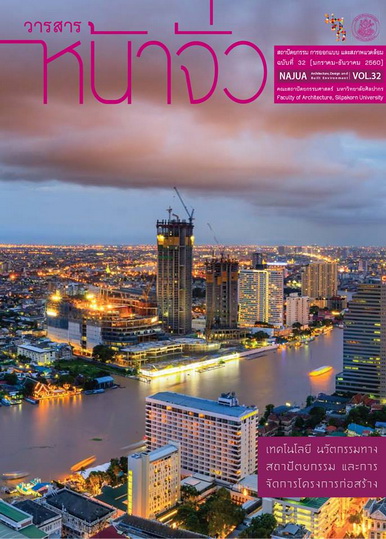การสะท้อนของแสงธรรมชาติจากลานทรายและความน่าสบายทางสายตาของมนุษย์ในวิหารโถงล้านนา
Keywords:
แสงธรรมชาติ, ค่าความสว่าง, ลานทราย, วิหารโถงล้านนา, Daylight, Brightness, Lanna Open sided ViharaAbstract
การสังเกตสภาวะแสงธรรมชาติในอาคารวิหารโถงล้านนา พบว่ามีสภาวะแสงที่นุ่มนวล และสงบนิ่ง ซึ่งเกิดขึ้นจากการให้ความสว่างโดยวิธีการใช้แสงสะท้อนของพื้นลานทรายที่อยู่โดยรอบอาคารวิหารโถงล้านนาที่มีรูปแบบแตกต่างกัน แต่ในด้านความน่าสบายทางสายตาของผู้ใช้งาน แสงธรรมชาติที่สะท้อนเข้ามาภายในอาคารมีความเพียงพอ มากเกินไปหรือน้อยเกินความต้องการหรือไม่ และมีผลรวมถึงความรู้สึกของมนุษย์ทางด้านวัฒนธรรมและความศักดิ์สิทธิ์ทางอาคารพุทธศาสนา กรณีศึกษาอาคารวิหารโถงล้านนา ในจังหวัดลำปาง 3 แห่ง คือ วิหารน้ำแต้ม วัดพระธาตุลำปางหลวง, วิหารจามเทวี วัดปงยางคก และวิหารหลวง วัดไหล่หิน โดยทำการวัดค่าช่วงฤดูร้อน (เดือนมีนาคม) เป็นเวลา 3 วัน วันละ 3 ช่วงเวลา คือ 9:00-10:00 น., 12:00–13:00 น. และ 15:00–16:00 น.
ผลการศึกษาพบว่า ประเด็นที่ 1 ค่าของแสงธรรมชาติที่เข้าสู่อาคารในฤดูร้อน สรุปผลได้ว่า วิหารโถงที่มีค่าเฉลี่ยความสว่างสูงที่สุด คือ วิหารน้ำแต้ม วัดพระธาตุลำปางหลวง 7,817.03 lx รองลงมา คือ วิหารจามเทวี วัดปงยางคก 4,472.94 lx และวิหารหลวง วัดไหล่หิน มีค่าเฉลี่ยความสว่างน้อยที่สุด คือ 1,026.51 lx ประเด็นที่ 2 ค่าความสบายทางสายตาภายในวิหารโถง ทั้ง 3 แห่ง พบว่า มีค่าความสว่างของแสงธรรมชาติสูงกว่าความต้องการใช้งานและค่าความสบายทางสายตา ประเด็นที่ 3 หากว่าค่าความสว่างมีผลต่อความรู้สึกศักดิ์สิทธิ์ในวิหารโถงล้านนา ค่าความสว่างเชิงปริมาณของแสงธรรมชาติในอาคารที่วัดได้จะมีค่ามากกว่า 1,000 Lux ขึ้นไป
The reflection of natural daylight from the open space and the comfort of the human sight in Lanna open sided Vihara
Chayada Wanichpong
Faculty of Arts and Architectureม Rajamangala University of Technology Lanna
Observation of daylighting in the Lanna open sided Vihara. It was found that the soft and calm lighting conditions were caused by the illumination by the reflection of the sandy court surrounding the building of the Lanna Hall with different forms. But in the eyes of the user comfort. The reflected light inside the building is sufficient. Too much or too little needs? And it also includes the human sensibility of culture and holiness in Buddhist buildings. Case study of Lanna open sided Vihara; Nam Tam Vihara at Pha Thad Lampang Luang Temple, Jammathevi Vihara at Pong Yang Kok Temple and Principle Vihara at Laihin Temple. By measuring and collecting data for 3 days during summer time (March). 3 times a day, 9:00 to 10:00, 12:00 to 13:00 and 15:00 to 16:00.
The results of this study are as follows: 1.) The values of daylighting entering the building in the summer were studied. In conclusion, the highest average brightness is Nam Tam Hall Pha Thad Lampang Luang Temple 7,817.03 lx. The second is Jammathevi Hall Pong Yang Kok Temple 4.472.94 lx. And Luang Hall Laihin Temple had the lowest brightness in the three buildings. The case study was 1,026.51 lx. 2.) The visual comfort. Inside three case studies of Lanna open sided Vihara, found that all have brightness values of daylighting higher requirements and visual comfort. 3.) If quantitative brightness of feeling associated with holiness in Lanna open sided Vihara. If the measured brightness affect the hall feel in the hall. Therefore, the brightness of the natural light in the building will be greater than 1,000 Lux.





